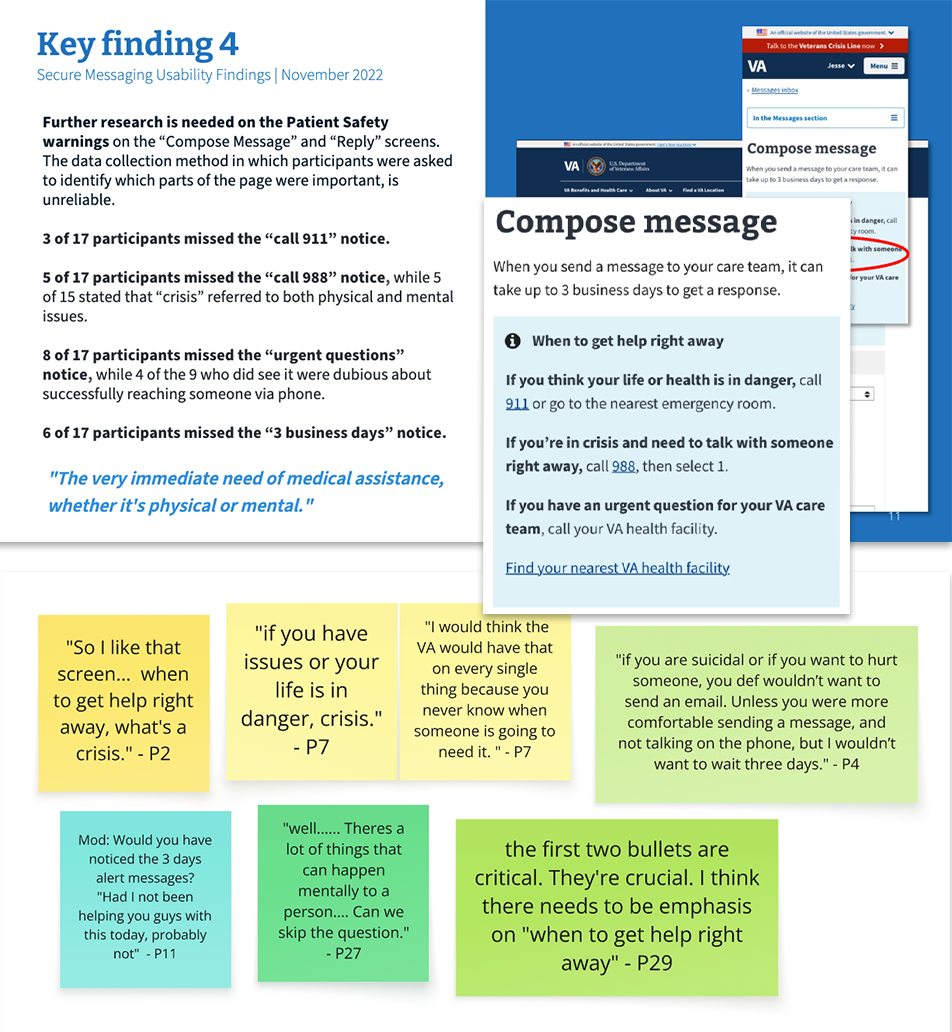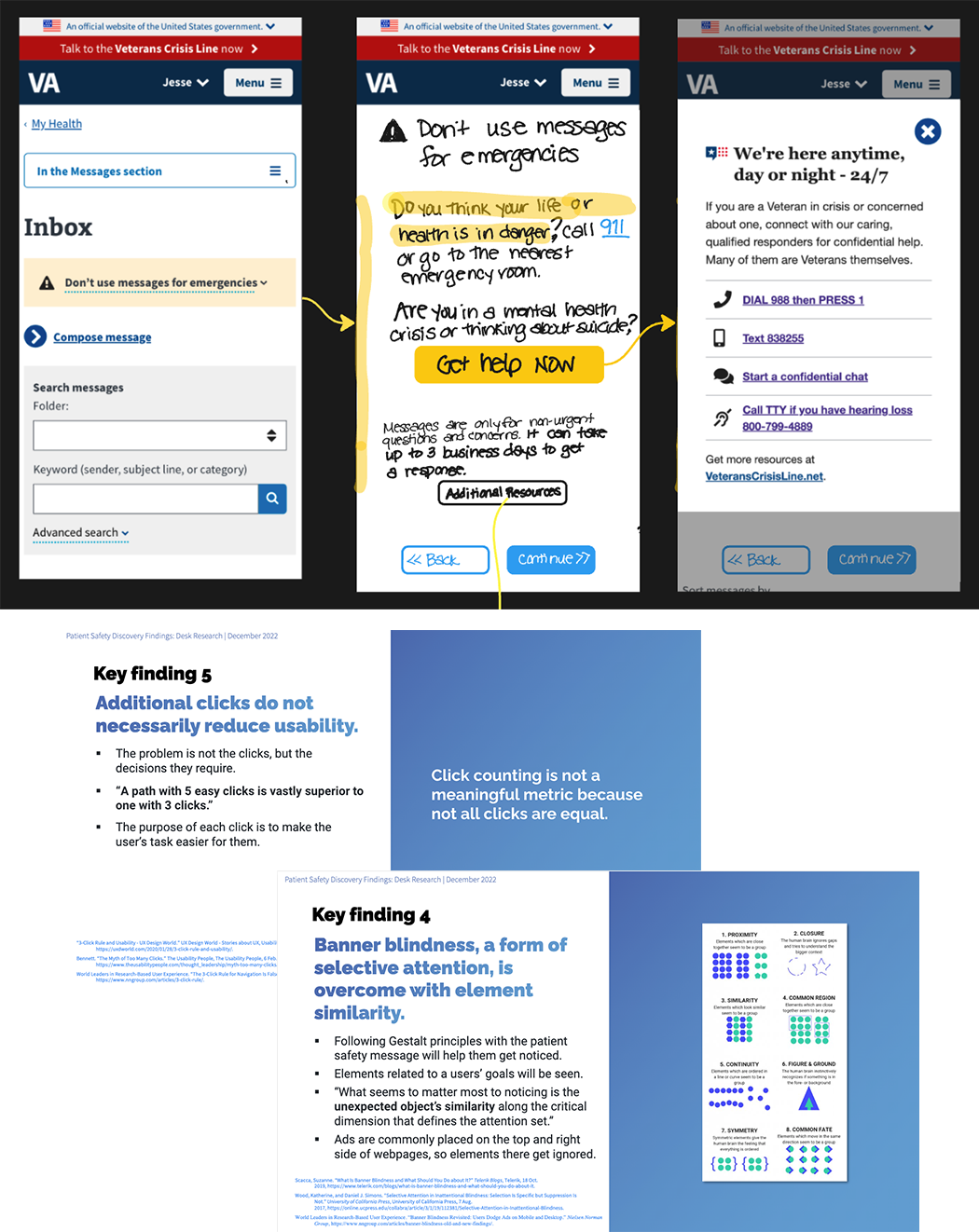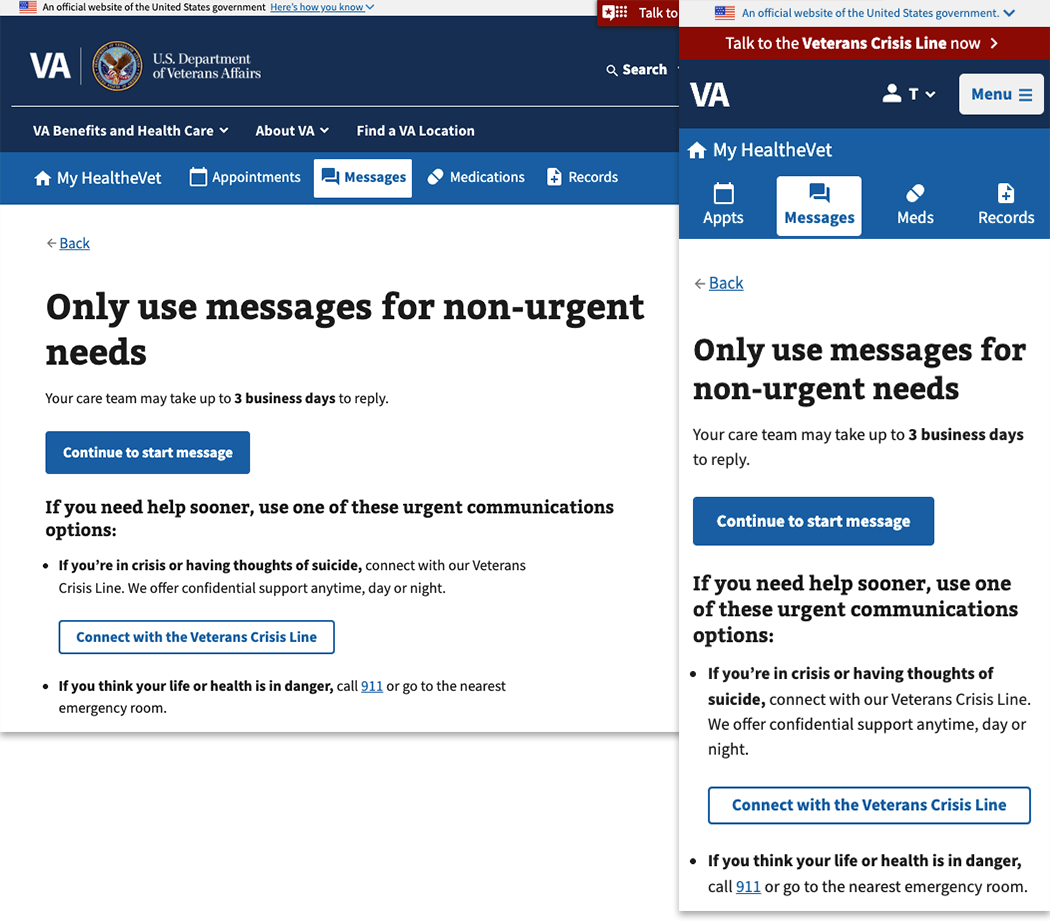
Turning Research Into Results: Saving Lives with Strategic UX
Client: Veteran Affairs
Timeline: November 2022 - February 2023
Role: UX researcher, design strategist, and primary stakeholder POC
1. Spotted a safety risk during usability testing
From Insight to Execution:
Veterans were missing or misinterpreting mental health crisis guidance.
2. Used research to propose an interruptive design
A new interstitial offered clear support options before message composition.
3. Advocated for Veterans and aligned stakeholders
Fought to keep direct crisis language, backed by clinical and content standards.
4. Tested and refined the design with all users
Including Veterans using assistive technologies like screen readers and voice command.
5. Validated the impact with real-world metrics
Minimal drop-off. Thousands clicking the Veterans Crisis Line. No usability loss.
Background: Modernizing Secure Messaging for VA.gov
As part of the Digital Health Modernization strategy, Veteran Affairs is consolidating key health tools into a single, streamlined experience on VA.gov. One of the most critical features being migrated is Secure Messaging, which allows Veterans to send non-urgent messages to their care teams.
Secure Messaging has long included a patient safety message, a policy-driven reminder that the tool is not intended for emergencies.
In 2022, our team began developing and testing a modernized prototype of Secure Messaging on VA.gov. After initial testing in June and July, we conducted a second round in November. It was during this round that a critical issue emerged.
Veterans Missed the Message (Literally)
During usability testing of Secure Messaging, most participants did not notice the 988 suicide prevention warning.
Many misunderstood the term “crisis,” thinking it applied only to physical health emergencies.
Critical safety language, like “call 911,” “urgent questions,” and the 3-day response disclaimer , was frequently overlooked or misread.
Several participants voiced concern that such life-saving guidance wasn’t more prominent or consistent.
The takeaway was clear: Mental health and suicide prevention messages were not breaking through. Veterans were missing them, and that presented a serious patient safety risk.
Discovery Uncovered a Critical Design Opportunity
Veteran suicide rates remain significantly higher than those of non-Veteran adults—particularly among younger adults aged 18–44.
Secure Messaging has been used to disclose high-risk symptoms, including depression, self-harm, and suicidal ideation.
These messages were sometimes sent within 30 days of suicide, ER visits, or psychiatric hospitalization—making timing critical.
Veterans with mood disorders often prefer asynchronous tools, meaning patient portals may be their first or only disclosure channel.
These insights revealed a serious patient safety risk and confirmed that a clearly worded, prominently placed notice was essential.
Ideating for Impact: Surfacing the Right Help, Right on Time
Simply placing another “Get Help” button wasn’t enough. Testing revealed that important safety messages were being missed due to banner blindness, poor placement, and lack of visual priority.
To ensure Veterans in crisis were offered immediate support:
I rejected passive options like placing links at the top/bottom of the screen, which blended in and were often ignored.
Instead, I proposed an interruptive pattern that pauses message composition and offers clear crisis resources before a potentially urgent message is sent.
Research confirmed this approach:
Click fatigue is not a concern when each interaction serves a clear purpose.
Elements designed with Gestalt principles are more likely to be noticed and understood.
Veterans Crisis Line (VCL) resources already existed; we just needed to surface them strategically.
This intervention prioritized access to life-saving resources at a moment of potential disclosure, without derailing usability.
Aligning Stakeholders Around Content
One stakeholder expressed concern about using the word “suicide” in the safety message, fearing it might cause distress or lead to unintended outcomes.
As a certified ASIST (Applied Suicide Intervention Skills Training) professional, I knew:
Avoiding the word “suicide” can increase confusion, especially during a crisis.
Research shows that plain, direct language is more effective and does not increase risk.
To move the conversation forward:
I engaged subject matter experts from the Veterans Crisis Line.
Together, we presented evidence-based communication guidance to the stakeholder.
The result: we reached consensus on using direct, supportive language as seen in the final version.
Final design by Jessica Robertson and Joel Calumpong
This collaboration ensured that Veterans in crisis would receive clear, unambiguous support, grounded in clinical best practices.
Evaluating the Solution Through Usability Testing
I conducted moderated remote usability testing via Zoom with 19 Veterans across desktop, tablet, and mobile devices. Sessions took place from January 27 to February 7, 2023, and focused on evaluating the new interstitial screen and patient safety messaging flow.
100% of participants responded favorably to the Veterans Crisis Line (VCL) link and modal.
Many appreciated its direct language, and none were triggered by the use of the word suicide.
Most participants tolerated the interrupted flow well.
Reactions ranged from neutral (“It was fine.”) to positive (“It’s important to include this.”)
Even participants who initially expressed hesitation softened once they understood the purpose.
Findings confirmed that the flow was respectful, intuitive, and capable of surfacing help when Veterans need it most.
Final Iteration: From Approval to Accessibility
The final design for the patient safety interstitial was immediately approved by My HealtheVet leadership and deployed to production in June 2023.
In September 2023, we conducted an additional round of usability testing with Veterans who rely on Assistive Technologies including screen readers, magnification tools, and voice command.
Final design by Jessica Robertson and Joel Calumpong
This final round ensured that the experience was not only usable and effective but also inclusive and accessible to Veterans of all abilities.
The Metrics Tell the Story
Despite some early stakeholder resistance to the added step, I continued to advocate for keeping the interstitial, supported by research findings and VA leadership.
Impact Metrics:
Veteran engagement has remained strong: Funnel analysis shows a consistent drop-off rate of just 3.5%, indicating that the interstitial does not deter message use.
Veterans are using the Veterans Crisis Line link: During a 28 day period in June, it was clicked 1,707 times.
This suggests that Veterans are either learning about the VCL or receiving life-saving support in their moment of need.
The data confirms what the research showed: a well-placed, clearly worded safety message supports Veterans—without disrupting their experience.
The Power of a Single Finding
This project began with a research insight: a pattern of missed warnings and misunderstood mental health messaging. From that moment on, I advocated for Veterans at every stage, from ideation through implementation and refinement.
I challenged assumptions about what was “enough” to keep users informed.
I partnered with stakeholders, clinicians, and accessibility experts.
I used both qualitative and quantitative evidence to defend a design that some initially wanted to remove.
This work is a reminder that the right intervention doesn’t always start with a stakeholder ask; it starts with research.







